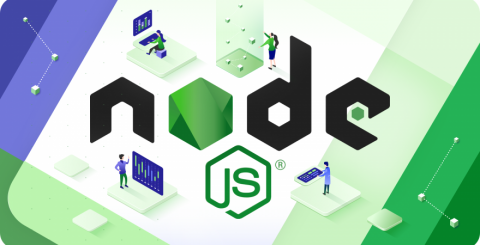Why Node.Js Has Become So Popular Among The Developers In Javascript Universe?

JavaScript universe has been phenomenal in mobile application development and its popularity among the developers worldwide is proof of it. But, when Ryan Dahl released node.js in 2009 as a JavaScript for the development of server-side applications, it became an instant sensation and over the years adopted by several tech giants and firms all over the world. Among the few that first adopted the technology was, Netflix, eBay, Uber, Walmart, etc. As an open-source project, Node.js was sponsored by Joyent, a cloud computing and hosting solutions provider. Which then went on to be the first to use node.js for mobile application development.
What is Node.JS?
Node.JS or Node is built on Chrome V8 Javascript runtime environment for the development of faster, scalable and lighter mobile applications. It uses an event-driven, non-blocking I/O model that makes it more efficient and lightweight, perfect for data-intensive real-time applications.Node.js uses an event loop within a single thread instead of multiple threads and can scale to millions of concurrent connections. The server can continue processing the incoming request, while I/O is processing, as Node is always asynchronous.
Node.js Modules:
(Rauch, G. (2012). Smashing Node.JS JavaScript Everywhere. John Wiley & Sons Inc.)
There are three modules, core modules, third-party modules, and local modules. Core modules are inbuilt, pre-installed modules of node.js and Core modules are referenced simply by name while local modules and third-party modules map into a file path. Third-party modules are modules registered in NPM (Node Package Manager) and installed using npm command. NPM by default dumps modules installed from NPM repository into node_modules local directory. And local modules are self-created modules.
NPM-Node Package Manager:
This is a pre-installed package manager, which involves downloading packages of various local modules, self-published by resolving dependencies, running tests, and installing npm command-line utilities. The main purpose of NPM is to make it easier for developers to access and install reusable components from public libraries and repositories. A full list of packaged modules can be found on the NPM website https://npmjs.org/ or accessed using the NPM CLI (Command Line Interpreter) tool that automatically gets installed with Node. The Node’s module ecosystem is open to all, and anyone can publish their own module to be listed in the NPM repository.
How Node.js works?
Earlier, web browsers use to spawn new threads for each request to handle the concurrency. While node.js can handle concurrency of several connections and requests through a single thread system. Thus, a node js developer can develop an application high in response and low on memory footprint.
Non-Blocking Event Loop Feature:
The conventional blocking type feature used to block subsequent requests send to the server when the server was performing an I/O cycle. Node.js uses an event-loop feature to allow request processing alongside the I/O cycle. It is a software pattern that facilitates non-blocking I/O combined with event-driven I/O, a scheme where a registered event callback function is invoked when some action happens in the program.
Single-Threaded model:
While earlier browsers used to create threads for every subsequent request during the server’s I/O operations. Node.js uses a single thread system for all the subsequent requests, non-blocking I/O process. Whenever a Node application needs to perform operations, it sends an asynchronous task to the event loop, registers a callback function, and then continues to handle other operations. The event loop keeps track of the asynchronous operation, executes the given callback and when it completes, returns its result to the application.
Asynchronous Programming Feature:
Asynchronous programming makes it possible to handle the requests by effectively utilizing the limited clock cycles and memory available to its single-threaded architecture. All the APIs(Application Programming Interface) exposed through node.js are asynchronous. Node integrates asynchronous programming in its architecture by means of asynchronous APIs with a callback function.
AJAX and Node.js:
AJAX is another technology run on JavaScript, that is often confused with node.js. However, both are quite different from each other. AJAX is used for client-side operations for dynamic updates of all the content pages without refreshing it. While node.js is used for server-side application development with a complete stack of components. Asynchronous JavaScript and XML(AJAX) is a technique used for the development of web-based software or web-applications for client-server. This unlike node.js does not allow data exchange from end-user to client-server back and forth.AJAX enables applications to update pages, only in response to user actions on the page. It does not solve the problem of updates coming from the server.
Node.js as the popular JavaScript environment:
According to Nodesource, there has been substantial growth in contributors to the development of applications using node.js. mNode.js registered a whopping 368,985,998 downloads up till the end of 2018 from 2014. In 2018 alone nearly 600 contributors contributed towards node.js project along with 230 unique core contributors in October 2018 alone. Among the companies that have implemented Node JS are Amazon, Netflix, eBay, Reddit, LinkedIn, Tumblr, and PayPal. Some of the reasons to choose Node JS are the “futuristic” features (Amazon) and because it reduces startup time (Netflix). The application area of Node JS includes IoT, crowdfunding, e-commerce, and payment processing. More than 85 countries and users with 45 different native languages use Node JS worldwide.
In AJAX, Clients always have to query the server community for new data that is available for application and the server cannot push data without being asked by the client, which leads to users, unable to see the real-time data.
Wrapping it Up:
If your application is on the server-side, with lots of data exchange between the server and end-user, you should go with node.js. Also, it is a great runtime environment for the development of cloud-based applications. As we already explored how node.js is easy, fast, lightweight and effective to develop highly responsive mobile applications with the lowest possible memory footprint. node.js is a popular choice when it comes to the development of applications in native script. JavaScript itself has been quite different from node.js, though node.js uses JavaScript as the platform.
Similar Articles
In today's competitive business environment, companies are continually seeking ways to enhance efficiency, improve decision-making, and streamline operations. Enterprise Resource Planning (ERP) software has emerged as a vital solution, integrating various business processes into a cohesive system
Ultrasonic cleaning is a powerful, non-invasive method for removing contaminants from surfaces. Using high-frequency sound waves, ultrasonic cleaners create microscopic bubbles that implode upon contact with dirt, oils, or grime, effectively lifting them off.
When we think about efficient transportation within large buildings or crowded areas, we often imagine escalators or elevators. However, there’s another key player in the world of horizontal transportation: moving walkways.
Discover 6 essential IT security policies to protect your organization from cyber threats. Build a robust, compliant, and secure infrastructure today!
Nowadays, the IT world is not imaginable without the cloud. It is extremely difficult to replace the cloud because the technology is bound to evolve. In this constantly changing technology world, nothing can be forecasted. Nevertheless, the cloud has deployed itself in such a way that has become irreplaceable.
A Data Management Platform (DPM) can be defined as a smart assistant that collects data or information from various places, such as websites, apps, and customer databases. A detailed description of the customers is then generated, which contains information about their preferences and behavior
Software testing is imperative to the software development lifecycle, typically ensuring that applications work as intended and fulfill user expectations. Test Data Management (TDM) has become a rather crucial aspect of effective software testing.
It has been amply evident that there is a keen focus on delivering quality software products quickly. Here, DevOps emerges as an effective solution to meet such market demands. After all, it enables organizations to accelerate software delivery while improving business outcomes.
Many factors have driven the transformation of the world around us. Yet, the credit primarily goes to digital technologies. This much has been for everyone to see. This transformation has been fueled by advances in AI and cloud computing, among other novel technologies.









